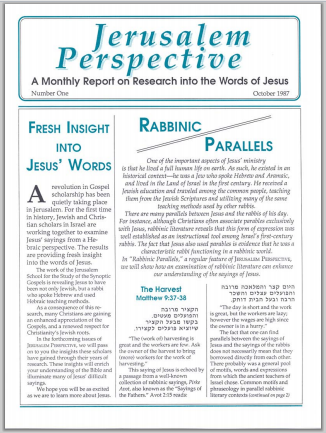From time to time, one hears reports of the discovery of a portion of the New Testament written in Hebrew or Aramaic. To date, such reports have proven false. There is not a single extant Hebrew-language or Aramaic-language manuscript from the early Christian era of any of the New Testament books.
Facts
- All of the canonical gospels—Matthew, Mark, Luke and John—were written in Greek.
- As the author of the Gospel of Luke states in his prologue (Luke 1:1-3), many written accounts of Jesus’ life already were in circulation.
- The early church fathers testify that the disciple Matthew wrote “the words of Jesus” in “Hebrew.”
- There are many Semitisms in the Synoptic Gospels.
Those are the bare facts of the matter. Any further statement regarding the original language of the life story of Jesus is conjectural. A conjecture may enhance understanding, and it may even be correct. But until it is proven, it cannot be treated as fact.
My Assumptions
I have arrived at two conclusions that serve as working hypotheses for my research:
- An account of Jesus’ life was written in Hebrew, probably by one of Jesus’ original disciples.
- One (or more) of the sources used by the writers of the Synoptic Gospels is derived from a Greek translation of that Hebrew account.
I cannot claim that the Gospels of Matthew, Mark and Luke were originally written in Hebrew. I conjecture only that the authors of the Synoptic Gospels used sources that were derived from an earlier Hebrew gospel. In fact, not every part of the Synoptic Gospels shows Semitic influence. Many parts, such as the prologue to Luke’s Gospel, show little or no Semitic influence.
Semitic Influence
On the other hand, there are non-Gospel portions of the New Testament that show Semitic influence. For example, the first half of the book of Acts, up to 15:35, is noticeably more Semitic than the second half (cf. Max Wilcox, The Semitisms of Acts).
R. H. Charles, the great English New Testament scholar of the turn of the twentieth century, argued that portions of the book of Revelation were translated from Hebrew sources (International Critical Commentary). I am sympathetic to Charles’ view. (Contrary to what one might expect, however, the book of Hebrews is written in the purest Greek of any book in the New Testament.)
While there are various degrees and types of Semitic influence throughout the New Testament, I recognize that all the books of the canonical New Testament, including the Synoptic Gospels, were written in Greek. However, my research has consistently shown the importance of recognizing the profoundly Jewish and Hebraic background of the Synoptic Gospels. I firmly believe that a Hebraic perspective is the key to better understanding these three Gospels.
For further reading, see my articles: “Hebraisms in the New Testament,” Encyclopedia of Hebrew Language and Linguistics (Leiden: E. J. Brill, 2013; Vol. 2, pp. 198-201); “Jesus’ Petros-petra Wordplay (Matt 16.18): Is It Greek, Aramaic, or Hebrew?” in The Language Environment of First-century Judaea: Jerusalem Studies in the Synoptic Gospels 2 (JCP 26; ed. Randall Buth and R. Steven Notley; Leiden: E. J. Brill, 2014), 375-394.
































































































